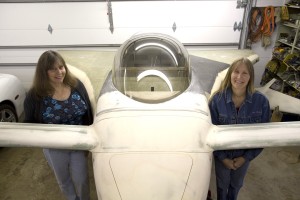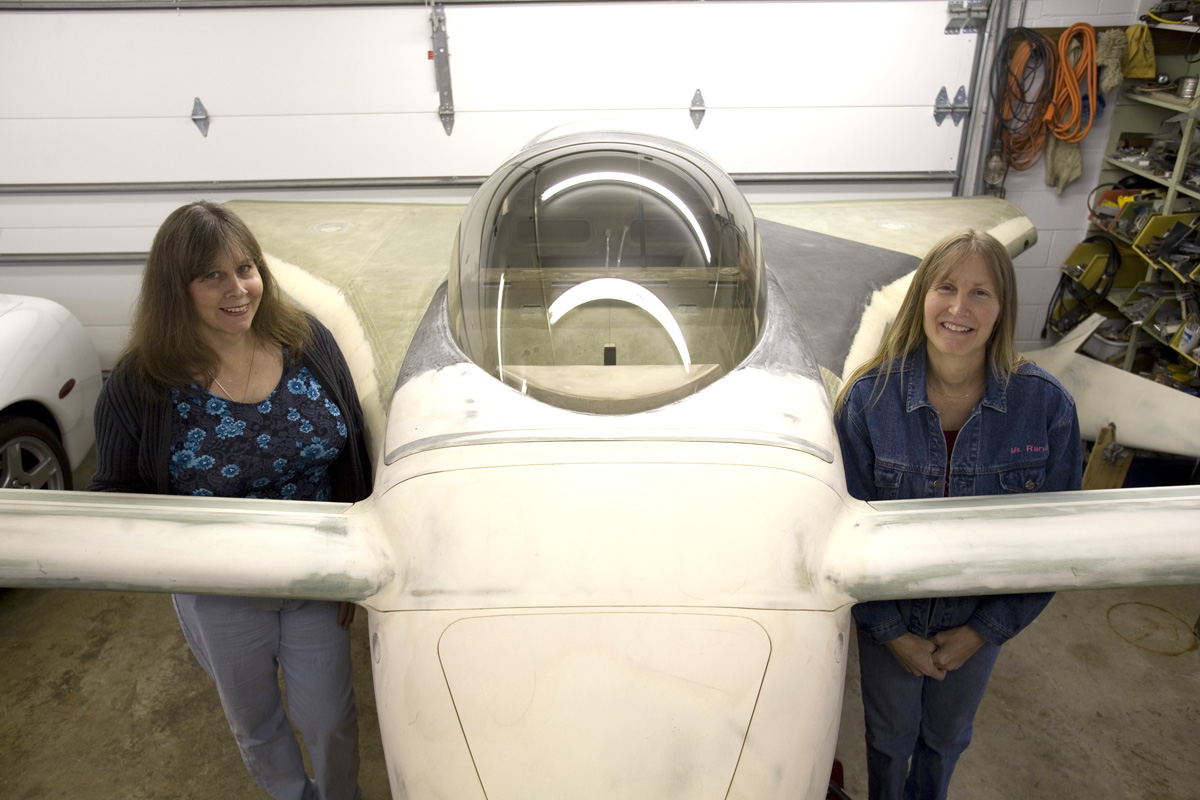
Chrissi Busch (left) and Randi Kelcher pose next to the new strakes they created for their Cozy Mark IV.
By Scott M. Spangler
Business is brisk at CG Products, but customers rarely visit its headquarters in St. Charles, Mo. The trip isn’t necessary; people shop on the company website for custom aircraft hardware and parts for amateur-built experimental aircraft and have the parts shipped to them. Customers and visitors do occasionally stop by, however, and company founders Chrissi Bush and Randi Kelcher give them all the same instruction: “Come to the back door.”
The company’s location is a three-bedroom home with a two-car garage. It doesn’t stand out from its neighbors—except for a second two-car garage in a corner of the backyard. Visitors entering the back door instantly step into the dining room. A glance to the right reveals a kitchen any gourmet would love, complete with a water spigot over the stove to fill the pasta pot.
To the left, basement stairs separate the dining room from the living room, picturesque with its fireplace and window offering a great view. At the head of the stairs is a large metal rack filled with gray plastic bins, each holding airplane parts swaddled in plastic. Behind the front door is a turbocharged Mazda 13B rotary engine. Perched on it is Kitty, a large blue and gold macaw that has made a short flight from her cage to the engine’s silver, cast-aluminum intake manifold.
Eventually, the engine will mate with a Cozy Mark IV that shares the garage with a white Corvette. But right now, the engine needs a lighter, more efficient intake and an end-cap that has mounting ears for a dynafocal engine mount.
Bush and Kelcher started building the airplane in the spring of 2001. They never imagined it would lead to CG Products, the business they opened in January 2006.
Earlier in their professional lives, this perfectly matched pair of entrepreneurs worked in high-tech fields as independent innovators and for corporations. They met by chance during Kelcher’s 1998 visit to Portland, Ore. Bush, running her product prototyping business, had recently moved there from Northern California’s Silicon Valley. About six months later, she visited Kelcher, who was also self-employed, in St. Louis, Mo. Bush realized that her move to Portland had been a bad choice, and Kelcher suggested that she think about moving to St. Louis.
“At the time, she had a 1,400-square-foot garage building that was doing nothing, and was perfect for me to work in,” Bush says. “I moved a few months later.”
Tall and soft-spoken, Bush is a right-brained artist. She wears one of her creations on her right wrist: a Cozy flies on a wide silver bracelet in bas relief before perfectly placed fair weather cumulus clouds. Another creation is a heated pitot tube that started life on the wing of a Cessna; destined for the nose of the pusher-powered Cozy, it’s now centered in a sculpted annular inlet ring on three streamlined stanchions. Both masterpieces were created on a four-axis, computer-numerically-controlled mill and lathe that Bush built originally for making jewelry.
A self-described Air Force brat and dynamic, articulate extrovert, Kelcher is the left-brained organizer and doer. She and four siblings learned from their parents’ example that there was nothing they couldn’t achieve through focused effort.
Kelcher’s father was an electronics engineer for McDonnell-Douglas and an inveterate inventor and builder. When she was 16, they planned to build an airplane. That project didn’t happen, but the idea stayed with her. Living and working at her place off the end of Lambert-St. Louis International Airport kept the idea alive. Several years later, Lambert forced the move to the St. Charles location when its expansion plan grabbed Kelcher’s land.
Neither Kelcher nor Bush is a pilot, but the latter started flying lessons when she was growing up around Cape Cod. Exposure to aviation again in St. Louis reignited Bush’s desire to fly. This further inspired Kelcher, and they put buying an airplane before flying lessons. They decided that building an airplane was more affordable than buying something ready-made.
As an artist, Bush had always been drawn to the canard’s tail-first lines. She’d also had some experience with the materials from which it was made: foam, glass cloth and resin. After a good deal of research, they ordered the plans for a Cozy Mark IV, a four-place canard pusher designed by Nat Puffer. With a 180-hp Lycoming, it cruises at 170 knots.
Starting work, they became proactive members of the homebuilding community, seeking and sharing new ideas in person and online. That activity led to their nickname. As they arrived at a meeting of the local Experimental Aircraft Association chapter, a member combined the name of the airplane they were building with the word on the vanity plate of Kelcher’s white Corvette.
“Hey, the ‘Cozy Girrrls’ are here,'” he said.
Building an airplane is an endless opportunity to learn new skills. The pair’s mantra for building is the same as it is for their business endeavors: “Do it right.” Both women are problem solvers, and they bounce ideas off each other to arrive at the best solutions.
“Ideas are complicated at the beginning,” Kelcher says. “But when you’re done thinking them through, the solutions are simple.”
Given the creative nature of their careers and personalities, the airplane wouldn’t be stock. Like its canard inspiration, Burt Rutan’s two-seat Long-EZ, the Cozy has a retractable nosewheel. Bush and Kelcher have replaced the fixed main gear with a retractable gear. Instead of running the gear’s hydraulic lines through the cabin to the nose-mounted pump, they located them in new, larger wing strakes that also give the cabin’s occupants more elbow room. Other touches include separate front and back seat canopies with four-pin security and external handles.
Stock or improved, it takes time to make parts, especially the smaller metal components such as torque tubes, bushings, mounting tabs and hinges. Since the 1970s, the Ken Brock Manufacturing Company made these parts for several homebuilt designs, including the Cozy. Brock died in 2001, and after several years, his widow decided to close the business. Worried that no one would make these essential parts for the Cozy, Bush and Kelcher seized the opportunity to exercise their high-tech design skills in the manufacturing arena as CG Products.
Piece by piece, they digitized almost every part. This enables CG Products’ vendors with the necessary water jet or laser cutters to produce small batches of parts with close tolerances. Creating electronic models and using computer-controlled production made it easier to improve the parts whenever possible, and each one’s value-added features are itemized on the company website.
For example, instead of six separate pieces welded together, the canard torque tube is now made of four laser-cut, CNC milled and TIG welded pieces that are cadmium plated. Almost all parts are primed, powder coated, alodined or cadmium plated to prevent corrosion. Metal parts that are glassed into the structure are abraded, sandblasted or knurled to give the resin a better grip on the part.
The creative and meticulous craftswomen make a good number of parts in their basement shops. Kelcher’s shop reflects her preference for nuts and bolts work. A large rolling toolbox and a tidy workbench form a right angle. Storage cabinets subdivided by small sliding drawers are neatly arranged at the back of the bench. On the other side of the shop wall is a mountain of foam that reaches almost to the ceiling. All of the pieces, large and small, have curves and radii backed by straight lines and square corners.
Building a composite airplane is like sculpting. You start with rectangular blocks and cut away the pieces that aren’t aerodynamic. You save the scraps, because you never know when you’re going to need one little piece for something.
Bush has two workshops back to back. One side is for electrical work; on the bench is the prototype electronic controller for the Cozy’s recirculating cabin air system. The other side is a U-shaped space. Facing each other are the four-axis mill and lathe; between them is the computer that controls them.
On the mill, Bush is cutting a rectangular opening in a round torque tube, into which a machined insert must fit. By hand, this operation would take several attempts to achieve a perfect fit; then the builder would have to round off the ears on the aluminum insert, so its radius matches that of the torque tube. With the CG Products parts, all builders have to do is push the totally machined insert into the tube.
With their work well received, Bush and Kelcher have continued to build their business, their airplane and their knowledge and skills. In the backyard garage, next to her TIG welder, is Bush’s new English wheel, which in capable hands turns flat metal into compound curves. But life isn’t all about work.
By the garage door is Kelcher’s Harley-Davidson Sportster, but she says Bush has been riding it more, because her boyfriend is also a biker. And then there’s the latest project. With another friend, they bought a KR-2 in need of rehabilitation. Assuming they can suppress their creative urges to make that aircraft better, when it’s airworthy, it will be a good airplane in which to learn how to fly.
For more information about CG Products, visit [http://www.cozygirrrl.com].











